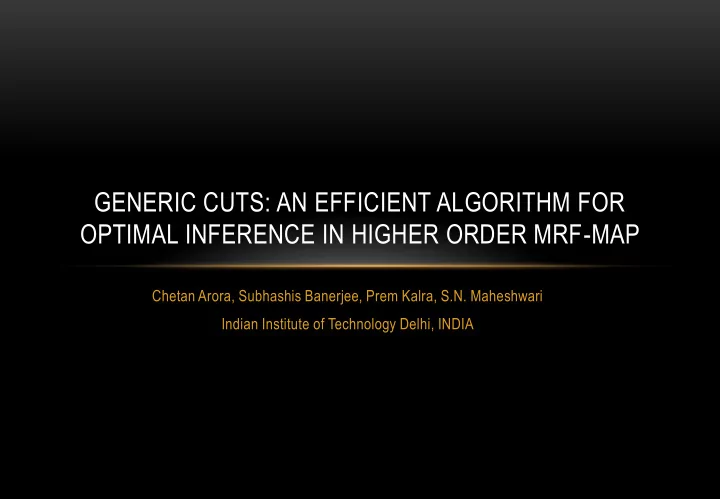

GENERIC CUTS: AN EFFICIENT ALGORITHM FOR OPTIMAL INFERENCE IN HIGHER ORDER MRF-MAP Chetan Arora, Subhashis Banerjee, Prem Kalra, S.N. Maheshwari Indian Institute of Technology Delhi, INDIA
MRF-MAP INFERENCE •
MRF-MAP INFERENCE •
HIGHER ORDER MRF – WHY? Input Disparity – 2 Clique Disparity – Smooth Gradient Woodford et al., PAMI 2009
POSSIBLE INFERENCE METHODS Reduction to 2-clique, followed by QPBO (Ishikawa, CVPR 2009; Rother et al., • CVPR 2009) • Problem decomposition + subgradient (Komodakis and Paragios, CVPR 2009) • LP-relaxation: e.g. Cutting-plane (Sontag et al., NIPS 2007) • Iterated Conditional Modes (ICM) • . . . Rother, INRIA Summer School 2010 New Reduction Techniques - Gruber, Boros and Zabih, ICCV 2011; Kahl and • Strandmark, ICCV 2011)
LIMITATIONS • Reduction Do not preserve submodularity. Inference using QPBO leaves many nodes unlabeled even • when the original higher order function is submodular Increase in the size of created graph. • BP/Dual Decomposition/ICM • • Convergence only in the limit. No guarantee on number of steps Observed slow convergence with increase in image size. •
MAIN CONTRIBUTION Need for development of direct algorithms for handling higher order clique problems We show 2-label higher order MRF-MAP can be formulated as maxflow problems When the clique potentials are submodular: Can be solved optimally and efficiently.
GADGET source m r p q n Primal Dual Justification in the paper sink
EDGE CAPACITY – DUAL FEASIBILITY CONSTRAINT m r p q n
EDGE CAPACITY – DUAL FEASIBILITY CONSTRAINT • m m p q r n
HOW DOES SUBMODULARITY EFFECTS US - MAXFLOW? 4 8 15 7 1 3 6 6 16
HOW DOES SUBMODULARITY EFFECTS US - MINCUT? 4 8 15 7 3 6 16 50
COMBINATORIAL PROPERTIES OF THE FRAMEWORK •
COMPARISON Ground Truth Noisy Input DD MPI ICM TRWS IQ GC IQ: www.f.waseda.jp/hfs/software.html DD / MPI / ICM / TRWS: drwn.anu.edu.au/
COMPARISON -ENERGY , CLIQUE SIZE=4 Image Size DD MPI TRWS IQ GC 50X50 219496 267018 221815 232197 219161 100X100 845883 1056459 848071 919249 843056 DD GC MPI
COMPARISON -TIME (MS) , CLIQUE SIZE=4 Image Size DD MPI TRWS IQ GC 50X50 2084 8 7769 86 4 100X100 14202 41 107873 493 14 DD GC MPI
COMPARISON – CLIQUE SIZE V/S TIME (MS) Image Size Clique Size DD GC IQ 100 × 100 4 15081 14 519 100 × 100 6 36683 103 7398 50 × 50 8 21290 159 32604 50 × 50 9 44872 435 206756 50 × 50 10 88577 1102 DNR 50 × 50 12 400543 7125 DNR
GENERALIZATIONS • Can be extended directly to find approximate solutions for non-submodular functions with uniform labeling costs zero. Can be extended by duplicating nodes to handle general non-submodular (similar to what is done • in QPBO for 2-clique non-submodular problems) Can be extended to handle sparse clique potential efficiently. •
SUMMARY •
Recommend
More recommend